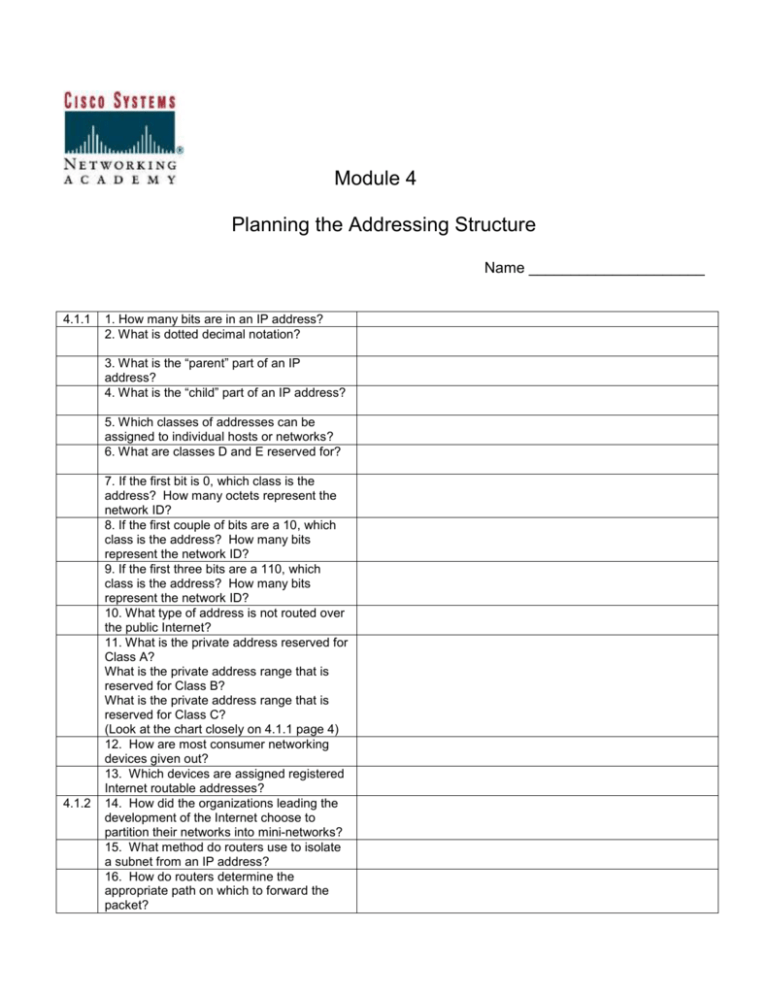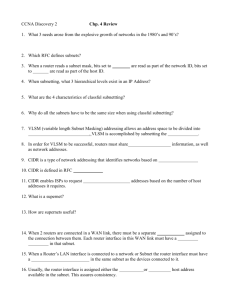Chapter 4
advertisement

Module 4 Planning the Addressing Structure Name _____________________ 4.1.1 1. How many bits are in an IP address? 2. What is dotted decimal notation? 3. What is the “parent” part of an IP address? 4. What is the “child” part of an IP address? 5. Which classes of addresses can be assigned to individual hosts or networks? 6. What are classes D and E reserved for? 4.1.2 7. If the first bit is 0, which class is the address? How many octets represent the network ID? 8. If the first couple of bits are a 10, which class is the address? How many bits represent the network ID? 9. If the first three bits are a 110, which class is the address? How many bits represent the network ID? 10. What type of address is not routed over the public Internet? 11. What is the private address reserved for Class A? What is the private address range that is reserved for Class B? What is the private address range that is reserved for Class C? (Look at the chart closely on 4.1.1 page 4) 12. How are most consumer networking devices given out? 13. Which devices are assigned registered Internet routable addresses? 14. How did the organizations leading the development of the Internet choose to partition their networks into mini-networks? 15. What method do routers use to isolate a subnet from an IP address? 16. How do routers determine the appropriate path on which to forward the packet? 17. What are the three levels created when subdividing a network? 18. Where are bits taken from in order to create a custom subnet mask? 19. For what reason is classful subnetting known as fixed-length subnetting? 20. What are the two considerations when planning subnets? 21. What is indicated if a bit in the host portion is set to all 0’s? 22. What is indicated if a bit in the host portion is set to all 0’s? 23. What are all-zeros and all-ones host addresses are reserved for? 4.1.3 24. How do a default subnet mask and a custom subnet mask differ from each other? 25. When creating a custom subnet mask, what is the first question that needs to be answered? 26. When subnetting, what are the two factors that determine the number of bits required for the subnet ID? 27. What is the equation to determine the number of hosts? 28. When creating a custom subnet mask, how are devices on the network informed of the subdivision? 29. What does subnetting minimize? 4.1.4 What does subnetting add? 30. What is a good practice when adding another device like a larger ISR? Complete the Activity on 4.1.3.4 Complete the PacketTracer Activity on 4.1.3.5 31. What do fixed-length subnet masks waste? 32. What does VLSM addressing allow? How is this done? 33. What does VLSM addressing save? 34. What does CIDR ignore? How does CIDR identify networks? 35. What were routers freed from by using CIDR protocols? 36. By removing that restriction what was eliminated? 37. What are Supernets? 4.1.5 38. What is required in order for a device in one subnet to communicate with a device in another subnet? 39. When determining how many hosts are needed in each subnet what should be included? 40. What must each router interface have? 41. What are two things that every configuration must ensure? 4.2.1 Complete the Packet Tracer Activity on 4.1.5 page 2. Print and complete Lab 4.1.5 page 3. 42. What does NAT allow a large group of private users to do? 43. What is one of the main reasons why NAT was developed? 44. How does NAT provide security? 45. What are 5 advantages of NAT. 46. What are 3 disadvantages of NAT. 47. How does NAT operate much like an access control list? 48. How is NAT a disadvantage with some applications that have IP addresses that must be translated in a message payload? 4.2.2 49. What does the term “inside local network” refer to? 50. What does the term “outside global network” refer to? 51. What does the term “inside local address” refer to? 52. What does the term “inside global address” refer to? 53. What does the term “outside local address” refer to? 54. What does the term “outside global address” refer to? Complete the activity on 4.2.2 page 2. 55. What does dynamic NAT allow? 4.2.3 56. How does dynamic NAT occur? 57. What is one way to provide access to a local host from the Internet? 58. What two things do static addresses ensure? 59. What does static NAT allow? 60. When should you configure static NAT? Complete the PacketTracer Activity on 4.2.3 page 3. 61. What does PAT translate? 4.2.4 62. How does PAT keep track of each individual conversation with the destination host? 63. When using PAT, what does the gateway translate? 64. If the global IP address is the same for multiple users, what is uniquely associated with the conversation? 65. What does the table in the router contain? 66. How is responding traffic directed? 4.2.4 4.2.5 67. How many unique port numbers are available? 68. How long is the unique port number and translation in place? 69. Why can’t users on the outside network reliably initiate a connection to a host that is running PAT? Print and complete Lab 4.2.4 page 3. 70. What is “an important issue” with NAT? 71. Why do some applications increase the work load of the router? 72. What three things are required for proper implementation of NAT? 73. What were three temporary solutions to the problem of IP address depletion? 74. What solution created more IP addresses? 75. List five areas of improvements for IPv6. 76. How many bits in length are IPv6 addresses? 77. How long is the global prefix of an IPv6 address? Who assigns the global prefix to a company or organization? 78. Who controls the subnet and the Interface Identifier (ID)?










